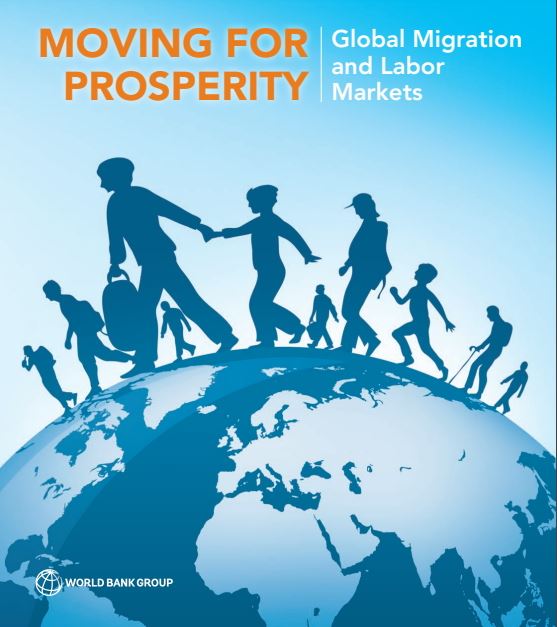 세계은행이 발행한 정책보고서 「번영을 위한 이주 : 국제이주와 노동시장」 표지
세계은행이 발행한 정책보고서 「번영을 위한 이주 : 국제이주와 노동시장」 표지
Contents
Foreword xi
Acknowledgments xiii
About the Team xv
Abbreviations xvii
Overview 1
The patterns of global migration: Scale 4
The patterns of global migration: Concentration 6
The determinants of migration 9
The short-term impact of immigration: Labor markets 15
Addressing short-term costs: Assistance and adjustment policies 19
The long-term impact: Immigrant integration and assimilation 22
High-skilled migration, agglomeration, and brain drain 27
International coordination of migration policy 35
Final thoughts 36
Notes 37
References 37
1. Patterns of Global Migration 39
Overall migration patterns 40
The concentration of economic migrants 51
Internal migration 57
Refugees 61
Migrant demographics 69
Notes 83
References 83
2. The Economic Drivers of Migration Decisions 85
Why migrate? The benefits of migrating 86
Why migrate? The costs of migrating 100
Why migrate? A cost–benefit analysis 116
Who chooses to migrate? Skill composition and the selection
of migrants 125
Annex 2A Gravity models 135
Notes 137
References 140
3. The Wage and Employment Impacts of Migration 145
Conceptual issues: The factor proportions approach 146
Empirical challenges: Immigrants and natives choose where to
live and work 149
Measurement challenges: Skill “downgrading” and
the undocumented 152
Empirical strategy I: The national skill cell approach 156
Empirical strategy II: The local labor market approach 161
Empirical strategy III: Natural experiments 164
Emigration and labor markets 173
Annex 3A Methodological challenges in the
immigration literature 175
Notes 180
References 182
4. Longer-Term Dynamics: Immigrant Economic Adjustment
and Native Responses 189
Economic integration of immigrants and refugees 191
Return and onward migration 209
Native responses to immigration 215
Notes 224
References 225
5. High-Skilled Migration 233
Defining a high-skilled migrant 235
Patterns of high-skilled migration 238
Determinants of high-skilled migration patterns 247
Impact of high-skilled migration on origin countries 254
Effects of skilled migration on destination countries 261
High-skilled migration policies 266
Note 272
References 273
제2장 이민 결정의 경제적 요인
C H A P T E R T WO
The Economic Drivers of Migration Decisions
사람들은 무수한 이유로 움직인다. 경제적 이주자이든 난민이든 모든 이주자들은 독특한 이야기와 경험을 가지고 있다. 경제학자와 연구자로서 우리의 일은 이러한 개별적인 이야기와 이주 경험의 공통적인 주제를 식별하는 것이다. 우리가 발견한 것은 더 나은 삶을 찾는 것이 이러한 주제들 중 가장 중요하다는 것이다. 즉, 더 높은 임금과 더 나은 일자리를 추구하는 것이 많은 사람들에게 이민의 핵심 결정 요인이다. 이 장은 국제 및 국내 이주 결정에 동기를 부여하고 형성하는 데 있어 이러한 요인의 역할을 식별하는 것을 목표로 한다. 사람들은 저임금 국가에서 고임금 국가로 이동하는가? 이주와 관련된 임금 상승은 얼마나 큰가? 다양한 이주 비용의 역할은 무엇인가? 노동 시장 변수는 이주 흐름의 규모와 기술 구성을 포함하여 다양한 이주 결과를 어떻게 결정하는가?
이 장에 제시된 기존의 경험적 증거에서 세 가지 광범위한 교훈이 나온다. 첫째, 경제적 비용과 편익은 이민 결정에 중요한 결정 요인이다. 잠재적 이민자들은 이사 여부와 장소를 결정할 때 이러한 비용과 이익을 고려한다. 그 증거는 사람들이 저임금 지역에서 고임금 지역으로 이동하고 현재와 미래의 고용 기회가 우수한 노동 시장에 매력을 느낀다는 것을 강하게 보여준다.
물리적 또는 문화적 거리는 잠재적 이민자에게 상당한 비용을 나타내며 관찰된 이주 패턴을 형성한다. 물리적 거리는 강력한 억지력이며 예산 제약이 빡빡한 저숙련 이민자 대부분이 인근 국가나 같은 지역 내에서 이동하는 이유다. 동화 및 정착 과정은 새로운 이민자들에게 매우 비용이 많이 들 수 있지만, 기존의 소셜 네트워크와 언어적 결합은 이러한 비용을 줄이고 현재 및 미래의 이주 흐름을 형성한다. 기존의 공동 국가 및 공통 언어의 네트워크는 신규 입국자가 일자리를 찾고, 사회생활을 확립하고, 수많은 관료적 장애물을 탐색하는 데 도움이 된다. 원주민과의 의사소통 능력은 인적 자본의 가치를 극대화하고 이주민들이 가정에서 얻은 학위와 자격 증명으로부터 완전히 이익을 얻는 데 필수적이다.
정책 환경은 일반적으로 이주에 추가되는 비용으로서 차이를 만든다. 특정 집단의 우대, 엄격한 국경 안보, 보건, 복지, 교육 혜택에 대한 접근 허용 여부에 관계없이 목적지 국가는 입국 허용 이민자의 규모와 구성에 상당한 영향을 미친다.
둘째, 이민의 경제적 영향을 결정하는 중요한 요인인 이민 흐름의 기술 구성은 출발지와 도착지 국가에 따라 매우 다양하다. 경제적 요인은 우리가 기술 구성에서 관찰하는 큰 변화를 다시 설명한다. 고기능 이민자들은 자유롭고 선별적인 이민 정책을 가지고 있고 교육과 인적 자본에 대한 절대적이고 상대적인 수익이 더 높은 부유한 나라에 불균형적으로 끌린다. 물리적 거리, 언어적 차이 및 정책 장벽은 고숙련자가 더 쉽게 극복할 수 있으며, 소셜 네트워크는 이동성 비용을 극복하는 데 덜 중요하다.
마지막으로, 경제적 요인은 난민들의 목적지 국가 선택에 중요한 역할을 한다. 난민들이 대부분의 경제 이민자들보다 훨씬 더 심하게 제한된 조건에서 선택을 하지만, 다른 목적지를 선택하기 위한 그들의 동기는 비슷하다. 특히 경제이민자처럼 난민은 다른 특성을 일정하게 유지하면서 고임금 목적지 국가로 갈 가능성이 높다. 거리나 인접과 같은 다른 요소들이 난민들에게 더 중요한 장벽이 되는 경향이 있기 때문에 그들은 여전히 대부분 이웃한 가난한 나라에 가게 된다. 간단히 말해서, 난민들은 더 나은 삶을 찾고 있고, 경제적 당김과 추진 요인들은 그들의 결정에 비슷하게 중요한 역할을 한다.
Why migrate? The benefits of migrating 왜 이주하는가? 이주의 이점
이민의 주요 경제적 이익은 더 나은 고용 기회와 대부분의 이민자들의 더 높은 임금에서 나온다. 국제 이주 패턴은 노동 시장을 보내는 것과 받는 것의 임금 차이가 특히 중요한 역할을 한다는 것을 보여준다. 이주민들은 저임금 국가에서 고임금 국가로 체계적으로 이주하며, 일반적으로 평생 동안 큰 임금 상승을 경험한다.
Wage differentials and migration 임금격차 및 이주
기본적인 경제적 직관은 생산 요소가 무엇이든 그렇듯이 사람들이 저임금 지역에서 고임금 지역으로 이동하는 것을 관찰해야 한다는 것을 시사한다. 이러한 패턴을 보여주기 위해 세계은행의 국제소득분배데이터(I2D2) 데이터 세트(I2D2에 대한 자세한 설명은 부록 참조)의 데이터를 사용하여 세계 88개국에 대한 평균(로그) 임금을 구성한 다음 각 국가 쌍에 대한 임금 차이를 계산한다. 그림 2.1은 이러한 양자 간 연간 임금 차이를 각 원천 국가에서 각 목적지 국가로 이민하는 사람들의 (로그) 몫과 비교한다.
이 수치는 출처와 목적지의 임금 차이가 더 클 경우 사람들이 두 나라 사이를 이동할 가능성이 더 높다는 것을 보여준다. 그래프의 기울기는 목적지 국가에서 평균 연간 임금이 2,000달러 증가하면 이민자가 그곳으로 이주할 가능성이 10% 더 높다는 것을 의미한다. 예를 들어, 슬로베니아인들이 캐나다와 미국으로 이주하는 경향은 대부분 임금격차에 의해 설명될 수 있다. 연간 임금은 캐나다와 미국이 슬로베니아보다 각각 21,000달러와 30,000달러 높으며, 이들 국가로 가는 슬로베니아 이민자의 비율은 각각 5.3%, 9%이다.
내부 이민의 경우에도 같은 패턴이 국가 내에서 유지된다. 그림 2.2는 2001년 인도 인구조사에서 나온 데이터를 사용하여 585개 인도 지역 간의 내부 이주를 보여준다.3 특정 지역으로의 이주 가능성은 상대적인 (로그) 임금 격차에 따라 증가한다. 그 관계는 국제 이주 흐름보다 더 뚜렷하고 정확하다. 한 지역의 평균 시간당 임금이 11% 증가하면 인도 국내 이주자가 그 지역으로 이주할 가능성이 10% 더 높아진다.
2000년 중국 인구센서스(제5차 전국 인구센서스)를 이용하여 334개 현에 걸쳐 유사한 이주율을 구성한다. 그런 다음 우리는 이 정보를 2001년 중국 도시 통계 연감 및 2001년 중국 통계 연감의 임금 정보와 결합한다. 그림 2.3은 각 현에서 각 목적지 현으로 이주한 이민자의 비율과 현 사이의 임금 차이를 비교한다. 이 수치는 한 현의 임금과 중국인 내부 이민자가 현으로 이주할 확률 사이의 명확하고 긴밀한 긍정적 관계를 보여준다.
난민들도 임금 격차에 반응하기도 한다. 난민들은 전쟁, 폭력, 민족 갈등, 그리고 박해 때문에 한 나라를 탈출한다. 하지만, 임금 수준은 여전히 그들의 목적지 선택에 영향을 미친다. 그림 2.4는 난민들이 본국과 목적지 국가 간의 임금 격차에 대비하여 특정 목적지 국가를 선택할 확률을 나타낸다. 경제적 이민자의 경우보다 정확하지는 않지만 긍정적인 관계는 분명하다. 이것은 아마도 난민들의 결정 과정에 들어가는 다른 비경제적 요인들 때문일 것이다. 이 데이터는 주어진 목적지에서 평균 임금이 1,000달러 증가하면 난민들이 그 목적지로 도망갈 가능성이 2.8% 증가한다는 것을 암시한다. 이 관계는 우리가 목적지 인구, 거리, 인접성 및 출발지와 도착지 국가 간의 언어적 유사성을 제어할 때 유지된다. 간단히 말해서, 난민들은 다른 모든 사람들과 마찬가지로 더 나은 삶을 추구하기 위해 동기부여가 되는 결정을 내리고 고임금 국가가 그것을 제공할 가능성이 더 높다는 것을 알고 있다.
Income gains from migration 이주로 인한 소득 증가
출발지와 도착지 간의 임금 차이는 이전 절에서 보듯이 국제 및 국내 이주자와 난민 모두에게 이주 결정의 주요 결정 요인이다. 이러한 패턴들이 이주민들이 실제로 이주할 때 그에 상응하는 임금 인상으로 이어지는가?
같은 직업에 대한 임금은 나라마다 극적으로 다르다. 심지어 맥도날드 직원들의 임금은 거의 동일한 기계를 사용하여 거의 동일한 제품을 생산하기 위해 거의 동일한 작업을 수행할 때 나라마다 10배만큼 차이가 난다. 아센펠터(2012)에서 가져온 그림 2.5는 임금과 맥도날드 근로자의 생산량 사이의 매우 높은 상관관계를 보여준다. 두 가지 중요한 관찰은 강조할 가치가 있다. 첫째, 경제 이론에서 알 수 있듯이, 근로자들은 한계 생산물의 가치를 받는다. 둘째, 노동자의 한계 생산성 수준은 완전히 표준화된 생산 환경에서도 크게 다를 가능성이 높다. 이러한 임금 차이가 국가 간 노동자의 기술 차이를 반영한다면, 이민자의 소득을 증가시킬 수 있는 이민의 능력에 대해 비관할 이유가 있다.
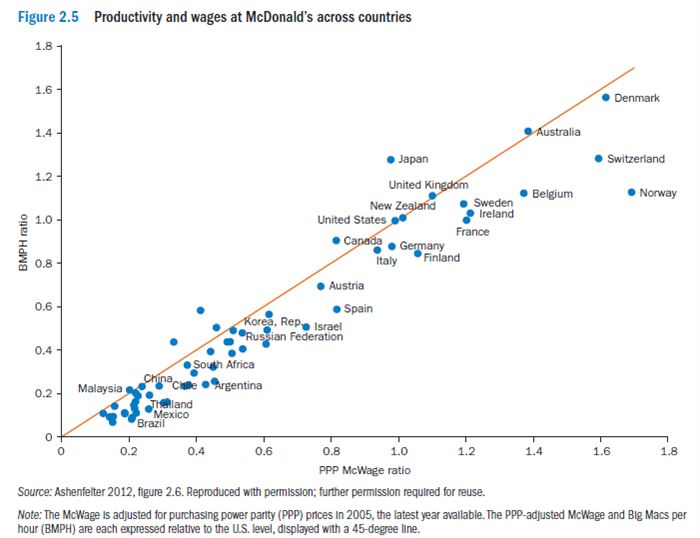
그러나 국가 간 경제 및 사회 환경의 차이는 이주민들이 임금을 올릴 수 있다는 것을 의미할 수 있다. 맥도날드에서 나온 증거는 시사적이지만, 이상적인 비교는 다른 나라에서 일하는 동일한 노동자들의 임금이 나라마다 얼마나 다른지 보는 것이다. 개념적으로 간단하지만, 이 사고 연습의 경험적 식별은 어려울 수 있다. 한 가지 접근법은 성별, 나이, 교육 등 관찰 가능한 특징에서 이민자와 "외모"가 동일한 비이민자를 찾아내고 이 두 그룹의 임금을 비교하는 것이다. 이는 클레멘스, 몬테네그로, 프리쳇(2016)이 미국의 이민자 데이터를 이용하여 채택한 접근법이다. 그들의 연구는 평균적인 개발도상국 출신의 전형적인 개인들이 미국으로 이주할 때 그들의 수입의 4배에서 6배까지 벌기를 기대해야 한다고 추정한다. 그림 2.6은 본국과 미국의 근로자 간 임금 차이를 보여준다. 이러한 임금 격차는 교육적 성취나 연령의 차이의 결과가 아니라는 사실은 이민자들이 가난한 나라에서 부유한 나라로 이주할 때 큰 임금 상승을 경험한다는 것을 시사한다. 한 사람을 생산적으로 만드는 많은 요소들은 본질적인 것이 아니라 그들이 일하고 사는 경제적, 사회적 환경의 결과이다. 결과적으로, 이주민들, 그리고 전 세계는 평균적으로, 사람들이 우수한 제도, 인프라, 그리고 상호보완적인 투자를 가진 더 부유한 나라로 이주할 수 있다면, 더 나은 삶을 누릴 수 있다.
그러나 임금 상승에 대한 이러한 추정치도 신중히 해석해야 한다. 첫째, 임금 상승은 일반적으로 국내총생산(GDP) 격차보다 작으며, 이는 이주와 함께 모든 생산성 차이가 완전히 제거되지 않음을 시사한다. 둘째, 더 중요한 것은 대부분의 데이터 세트에서 노동자의 인적 자본 및 기타 생산성 특성에 대한 정확한 측정치가 없다는 것이다. 이민자들은 조사나 인구조사에서 쉽게 측정되거나 포착되지 않는 많은 면에서 비 이민자들과 다를 가능성이 있다.
이민이 상당한 임금 상승으로 이어진다는 더 설득력 있는 증거는 이민 추첨으로부터 나온다. 이민에 대한 수요가 잠재적 이민 기회보다 훨씬 더 클 경우, 목적지 국가의 정부는 때때로 누가 이민을 갈 것인지를 결정하는 추첨을 제공한다. 이러한 추첨은 이민의 실제 임금과 고용 영향을 측정하는 "자연스러운" 실험을 제공한다. 추엄에 응모해 당첨된 개인과 당첨된 개인들을 패소한 개인과 비교함으로써, 우리는 이주가 임금 수입에 미치는 순수한 영향을 분리할 수 있다.
맥켄지, 스틸먼, 깁슨 외(2010) 및 깁슨 외(2018)은 일련의 논문에서 통가와 다른 태평양 제도에서 온 신청자 중에서 무작위로 투표하는 뉴질랜드의 태평양 접근 범주를 분석한다. 그림 2.7은 추첨 당첨자와 패자가 이주 전에 통가에서 비슷한 소득을 가지고 있었다는 것을 보여준다(약 $NZ 80 또는 주당 $58).
추첨에 당첨되어 뉴질랜드로 이주한 후 첫 해에, 이민자들은 비 이민자들보다 273% 더 많은 돈을 번다. 이러한 비교적 큰 임금 격차는 거의 10년 후에도 지속되며, 이주자들은 284% 더 많은, 즉 주당 359달러를 추가로 번다. 이러한 임금 차이는 생계비 차이에 따라 조정되므로 이민으로 인한 진정한 소득 이득을 나타낸다. 이러한 이득이 이주민의 직장 생활을 통해 지속된다고 가정하면, 깁슨 외 연구진(2018)은 뉴질랜드로 이주하는 현재 할인된 가치는 이주민 1인당 315,000달러(미화 237,000달러)라고 추정한다. 이 금액은 일반적으로 연구되는 수많은 개발 개입으로 얻는 소득보다 수십 배 더 크다. 다시 말해, 이주는 엄청난 임금 혜택을 제공한다.
Employment differentials and migration 고용 격차와 이주
이주의 흐름과 임금격차의 관계는 이주의 노동시장 동기에 관한 이야기의 일부만을 말해준다. 지리적 위치에 따른 고용률과 기회의 차이는 또 다른 중요한 요인들을 생성한다.
고용률이 국제 이주 흐름에 미치는 영향에 대한 증거는 거의 없다. 그럼에도 불구하고, 기존 데이터는 몇 가지 독특한 패턴을 보여준다. 그림 2.8은 목적지 및 원천 국가의 인구 대비 고용 비율의 차이에 대해 표시된 양국 경로의 이민자 및 이민자 점유율을 보여준다. 패널 A는 평균적으로 이민자들이 더 높은 고용 목적지를 선택하는 것을 보여준다. 패널 b는 평균적으로 이민자들이 저고용 국가에서 오는 경향이 있다는 것을 보여준다. 고용률이 높고 실업률이 낮은 목적지로 가서 다른 요인을 통제하는 경향이 있는 난민에게도 유사한 증거가 존재한다(그림 2.9 참조).
시간이 지남에 따라 국가 내 내부 이주의 변화는 이주 패턴의 고용 관련 결정 요인에 대한 풍부한 증거 자료이다. 특히 미국의 경우 노동시장 충격에 대한 이동성 반응에 대한 많은 문헌이 존재한다. 중심적인 관찰은 미국의 내부 이주율이 매우 순환적이며(Saks and Wozniak 2011), 대부분의 이민자들이 경제 호조기에 창출된 기회를 이용하기 위해 이동하며, 특히 강력한 경제 성장과 일자리 창출이 있는 지역에서 이동한다는 것이다. 그러나 내부 이주가 좋지 않은 시기에 부정적인 충격을 완화시키는지 여부는 덜 명확하다. 총이주율이 침체기에 하락하는 경향이 있다는 것은 미국 노동자들이 다른 지역으로 이동함으로써 부정적인 경제적 충격에 대응하지 않는다는 것을 시사한다. 대신, 비록 그 지역이 더 높은 실업률을 경험하고 있더라도, 사람들은 경제가 회복되기 시작할 때까지 현재의 위치를 유지한다(Mian and Sufi 2012; Moloy, Smith, Wozniak 2011).
몬라스(2015)의 최근 논문에서 주장했듯이 2007-08년의 금융 위기와 그에 따른 "대침체"는 약간 다른 패턴을 만든 것으로 보인다. 부정적 지역경제 충격을 촉발하는 데는 지리적 이전이 중요했다는 분석이 나온다. 그러나 재배치 메커니즘은 외부 이주 증가보다는 부정적인 영향을 받는 위치로의 내부 이주 비율을 줄이는 것을 포함한다.
같은 문제를 다루면서, 랜섬(2016)은 2002-13년 동안 실업자 사이의 이주율이 고용자 사이의 이주율보다 더 높았다고 관찰한다. 더 흥미로운 것은, 대공황 기간 동안 실업자의 이주율이 증가한 반면, 취업자의 이주율은 약간 감소했다는 것이다. 이 논문은 고용 상태별 이주율 차이가 관찰된 것은 주로 대공황에 따른 일자리 제안과 일자리 파괴율의 비대칭성에 기인한다는 것을 발견했다. 구체적으로는 일자리 제공률이 일자리 파괴율보다 약 5배 이상 감소했다. 게다가, 고용된 근로자들은 장소를 옮길 때 극심한 취업 대기 페널티를 받는 반면, 실업자들은 그러한 페널티를 받지 않는다. 이 두 가지 요소를 합치면 이주 가능성이 더 높은 실업 노동자와 대조적으로, 고용된 노동자는 현재 위치에 머물며 일자리를 유지할 동기를 부여한다.
Family and migration decisions 가족과 이주 결정
임금격차가 이주결정의 주요 동인이라는 주장에 대한 이의는 많은 사람들, 특히 여성들이 업무 관련 이유로 이주하지 않는다는 것이다. 연구에 따르면 가족 관련 사회적 이유가 종종 여성의 이주 결정에 영향을 미치는 것으로 나타났다. 예를 들어, 2001년 인구조사에 따르면, 인도 여성들은 남성들보다 내부적으로 이주할 가능성이 2.5배 더 높다. 그 이유는 결혼이 인도 여성의 내적 이주의 가장 큰 동기이기 때문이다. 그림 2.10(2015년 풀포드로부터 복제)에서 볼 수 있듯이 농촌 지역의 여성들에게 이주는 거의 보편적이다. 인도 대부분의 지역에서는 여성의 결혼이 출생지 밖에서 이루어지며, 남편의 가족과 함께 그의 마을이나 마을에 합류한다. 결혼은 인도 전체 여성 이주자의 71%를 차지한다. 남성들은 더 다양한 이유를 가지고 있다: 약 30 퍼센트가 일을 위해 이주하고, 비슷한 수의 사람들이 그들의 가족과 함께 이주한다. 결혼이주의 70퍼센트 이상이 가까운 거리 이상이고 지역 내에서 일어난다. 따라서 여성들은 멀리 이주하지 않는다: 오직 9%만이 주 경계를 넘어 이주한다. 한편, 인도 남성 이민의 20%는 주를 넘나들고 있다.
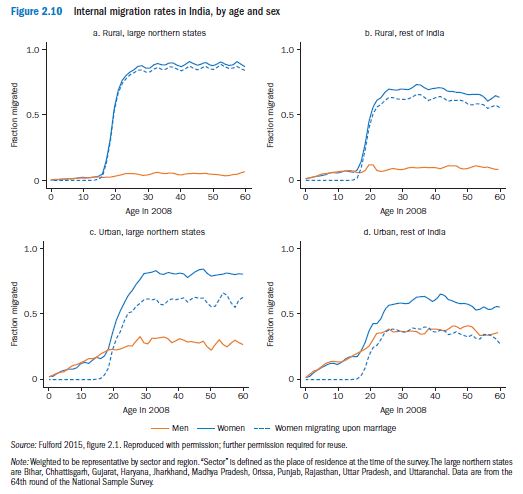
국제이주로 눈을 돌리면, 미국 이민통계국의 자료를 이용하여 미국으로 이민하는 사람들의 특징을 조사하는 것 또한 흥미로운 패턴을 보여준다. 업무와 관련이 없는 이유들은 미국으로의 국제 이민의 상당한 부분을 동기부여 하는 것으로 보인다. 가장 눈에 띄는 것은, 부양가족이 이 숫자에 포함된다는 사실에도 불구하고, 임시직 근로자와 그 가족에게 가는 모든 비자의 70%를 남성이 차지하고 있다는 것이다. 상대적으로 더 적은 수의 여성들이 H-1B 비자를 받는다. 이민 절차의 다음 단계, 영주권 상태 또는 그린카드의 경우, 그림 2.11은 영주권을 획득한 사람에 대한 정보를 성별에 따라 구분하여 보여준다. 이 자료에 따르면 2014년 여성 그린카드 수급자 중 48%가 가정주부였으며 이들은 대부분 가족통일 정책을 통해 그린카드를 발급받은 것으로 나타났으나 남성은 3% 미만이었다. 한편, 남성의 36%가 관리직이나 전문직을 가지고 있는 데 비해 여성은 16%에 불과했다.
분명히, 이주를 동기화하는 것에는 성별 차이가 있으며, 이는 의문을 제기한다. 임금격차, 실업률, 거리, 네트워크와 관련된 이주 패턴은 성별에 따라 다른가? 사용 가능한 데이터에 따르면 대답은 아니오, 이다. 여성과 남성은 종종 뚜렷한 이유로 이동할 수 있지만, 그들의 총 이동 패턴은 놀라울 정도로 유사하다.
그림 2.12의 패널 a는 국가별 성별 인구 대비 이민 비율을 보여준다. 사실상 모든 나라가 45도 선을 따라 놓여 있는데, 이는 각 성별의 동일한 비율이 이민을 간다는 것을 의미한다. 소수의 예외 중 일부는 여성 이민자가 많은 작은 나라들, 아르메니아, 그레나다, 요르단, 레바논, 그리고 더 많은 남성 이민자들이 있는 버진 아일랜드들이다. 전 세계 남성과 여성 이민율의 상관관계는 0.985이다.
성별에 따른 양자간 이주율을 분석하면 비슷한 패턴이 나타난다. 간단히 말해서, 같은 출신 국가에서 온 남성과 여성은 같은 비율로 같은 목적지 국가로 이주하는 경향이 있다. 그림 2.12의 패널 b의 산점도(scatterplot)는 여성 이민자의 비율에 대해 각 출발 국가에서 각 목적지 국가로 이동하는 남성 이민자의 (자연 로그) 비율을 보여준다. 관측치는 45도 선을 중심으로 촘촘히 모여 있으며 성별 간 상관관계는 0.97이다. 한 국가에서 온 남성과 여성 이민자들이 목적지 국가로 매우 비슷한 비율로 이주하지만, 이는 모든 양자 간의 흐름에 반드시 해당되는 것은 아니다. 예를 들어, 인도네시아에서 사우디아라비아로 가는 이민자 흐름은 불균형적으로 여성(가구 직원)인 반면 방글라데시에서 오만 및 말레이시아로 가는 이민자 흐름은 불균형적으로 남성(농업 및 건설 일자리)이다. 그러나 이러한 예외는 이러한 특이치 경로가 미디어에서 받는 관심에도 불구하고 자주 발생하지 않는다.
이 수수께끼에 대한 설명은 사실 남성과 여성 모두 취업과 관련된 이유로 움직이지만 여성은 "타이드 무버 tied movers"일 가능성이 더 높다는 것이다. 만약 개인이 더 높은 임금과 더 나은 고용 기회를 찾아 이주하고 그들의 배우자가 그들과 동행한다면, 배우자들은 바로 같은 경제적 이유로 간접적으로 이주하는 것이다.
CHAPTER TWO
The Economic Drivers of Migration Decisions
People move for myriad reasons. Every migrant, whether an economic migrant or a refugee, has a unique story and experience. Our job as economists and researchers is to identify the common themes to these individual stories and migration experiences. What we find is that the search for a better life is foremost among these themes. In other words, the pursuit of higher wages and better jobs is a key determinant of migration for many people. This chapter aims to identify the role of these factors in motivating and shaping international and internal migration decisions. Do people move from low- to high-wage countries? How large are the wage gains associated with migrating? What is the role of different migration costs? How do labor market variables determine various migration outcomes, including the size and the skill composition of migration flows?
Three broad lessons emerge from the existing empirical evidence presented in this chapter. First, economic costs and benefits are critical determinants of migration decisions. Potential migrants weigh these costs and benefits in deciding whether and where to move. The evidence strongly shows that people move from low-wage to high-wage locations and are attracted to labor markets with superior current and future employment opportunities.
Distance, whether physical or cultural, represents a significant cost to potential migrants and shapes observed migration patterns. Physical distances are powerful deterrents and the reason why most low-skilled migrants with tight budget constraints move to neighboring countries or within the same region. The process of assimilation and settlement can be very costly to new immigrants, but existing social networks and linguistic bonds reduce these costs and shape current and future migration flows. Preexisting networks of co-nationals and a common language help new arrivals find jobs, establish a social life, and navigate numerous bureaucratic hurdles. The ability to communicate with natives is essential to maximizing the value of one’s human capital and fully benefitting from degrees and credentials that migrants have earned at home.
Policy environment makes a difference, typically as an added cost to migration. Whether it is from preferential treatment of certain groups, tight border security, or granting access to health, welfare, and education benefits, destination countries have a significant impact on the scale and composition of the immigrants they allow to enter.
Second, the skill composition of migration flows, a critical determinant of the economic impact of immigration, varies enormously across origin and destination countries. Economic factors again explain the large variation we observe in skill composition. High-skilled migrants are disproportionately attracted to wealthier countries that have liberal and selective immigration policies and where absolute and relative returns to education and human capital are higher. Physical distances, linguistic differences, and policy barriers are more easily overcome by the high skilled; and social networks are less important in overcoming mobility costs.
Finally, economic factors play an important role in refugees’ choices of destination countries. Even though refugees make their choices under much more severely constrained conditions than most economic migrants, their motivations in choosing a particular destination over another are similar. In particular, like economic migrants, refugees are more likely to go to high-wage destination countries, holding other characteristics constant. They still mostly end up in neighboring poorer countries because other factors, such as distance and contiguity, tend to be more important barriers for refugees. Simply put, refugees are also in search of a better life, and economic pull and push factors play similarly important roles in their decisions.
Why migrate? The benefits of migrating
The main economic benefits of migrating come from better employment opportunities and higher wages for most migrants. International migration patterns show that wage differentials between sending and receiving labor markets play an especially important role. Migrants systematically move from low- to high-wage countries, and they typically experience large wage gains over their lifetime.
Wage differentials and migration
Basic economic intuition suggests that we should observe people migrating from low-wage to high-wage locations, as it would be the case with any factor of production. In order to show these patterns, we use the data from the World Bank’s International Income Distribution Data (I2D2) dataset (see the appendix for a detailed description of I2D2) to construct mean (log) wages for 88 countries in the world and, then, calculate wage differentials for each pair of countries.1 Figure 2.1 compares these bilateral annual wage differentials with the (log) share of emigrants from each source country to each destination country.2
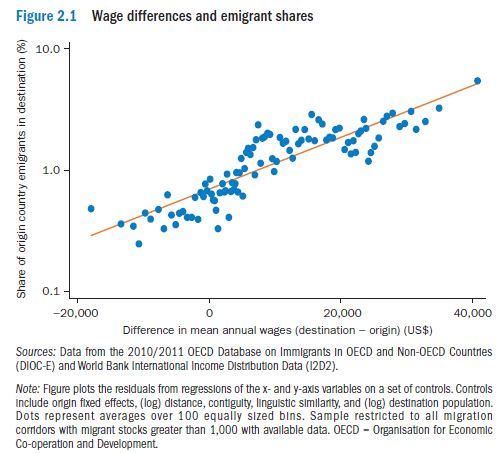
The figure reveals that people are more likely to move between two countries if the wage differences between the source and destination are greater. The slope in the graph implies that an increase of $2,000 in mean annual wages in the destination country makes an emigrant 10 percent more likely to choose to migrate there. For example, the propensity of Slovenians to migrate to Canada and to the United States can be mostly explained by wage differentials. Annual wages are $21,000 and $30,000 higher in Canada and the United States, respectively, than in Slovenia; and the fractions of Slovenian emigrants going to these countries are 5.3 and 9 percent, respectively.
The same patterns hold within countries in the case of internal migration. Figure 2.2 shows internal migration between 585 Indian districts using data from the 2001 Census of India.3 The likelihood of migrating to a particular district increases with the relative (log) wage differential. The relationship is more pronounced and precise than for international migration flows. An increase of 11 percent in mean hourly wages in a district makes an Indian internal migrant 10 percent more likely to migrate to that district.
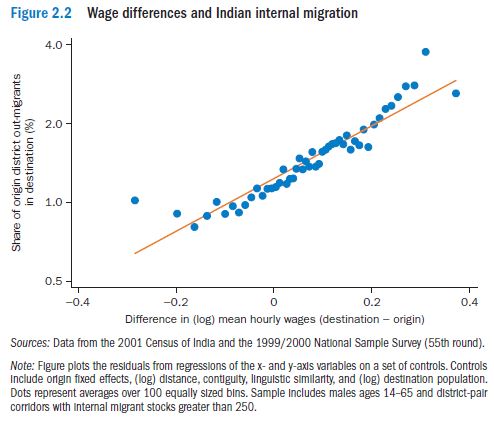
Using the 2000 Census of China (the Fifth National Population Census), we construct similar migration rates across 334 prefectures. We then combine this information with wage information from the China City Statistical Yearbook 2001 and China Statistical Yearbook 2001. Figure 2.3 compares wage differentials between prefectures with the fraction of emigrants from each source prefecture to each destination prefecture. The figure shows a clear and tight positive relationship between wages in a prefecture and the probability that a Chinese internal migrant moves there.
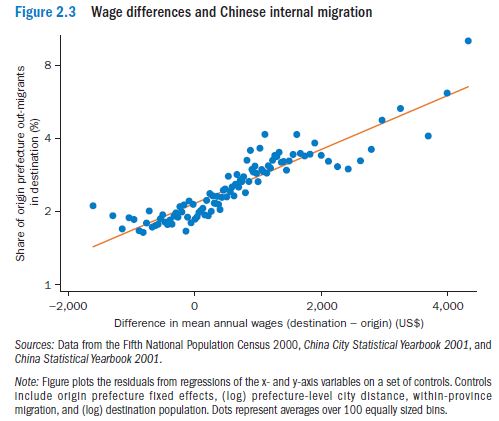
Refugees also respond to wage differentials. Refugees flee a country because of wars, violence, ethnic conflict, and persecution. However, wage levels still affect their choices of destination. Figure 2.4 plots the probability that refugees will choose a particular destination country against wage differentials between the home and destination countries. The positive relationship is clear, although less precise than in the case of economic migrants. This is possibly due to other noneconomic factors that enter into refugees’ decision process. The data imply a $1,000 increase in mean wages in a given destination makes a refugee 2.8 percent more likely to flee to that destination. This relationship holds when we control for destination population, distance, contiguity, and linguistic similarity between origin and destination countries. In short, refugees, like everyone else, make decisions that are motivated by the search for a better life and are aware that higher-wage countries are more likely to provide that.
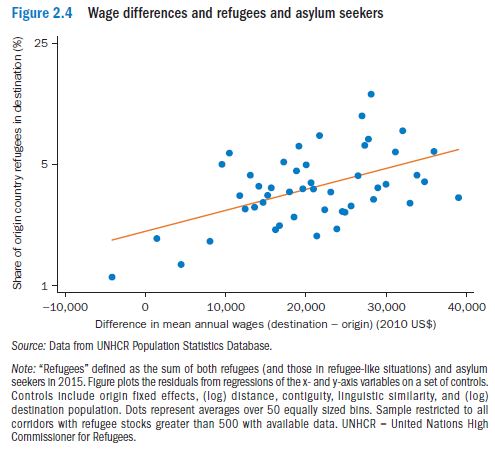
Income gains from migration
Wage differences between origin and destination locations are a major determinant of migration decisions, as shown in the previous section, for international and internal migrants and refugees alike. Do these patterns lead to corresponding wage increases for these migrants when they actually move?
Wages for the same jobs differ dramatically across countries. Even wages of employees at McDonald’s differ by as much as a factor of 10 across countries when those employees perform almost identical tasks, using almost identical machinery, to produce almost identical products. Figure 2.5, taken from Ashenfelter (2012), shows a very high degree of correlation between wages and the output of workers at McDonald’s across countries. Two important observations are worth highlighting. First, as economic theory suggests, workers are paid the value of their marginal product. Second, workers’ marginal productivity levels are likely to differ enormously, even in an entirely standardized production environment. If such wage differences reflect skill differences of workers across countries, there is reason to be pessimistic about the ability of migration to increase migrants’ incomes.
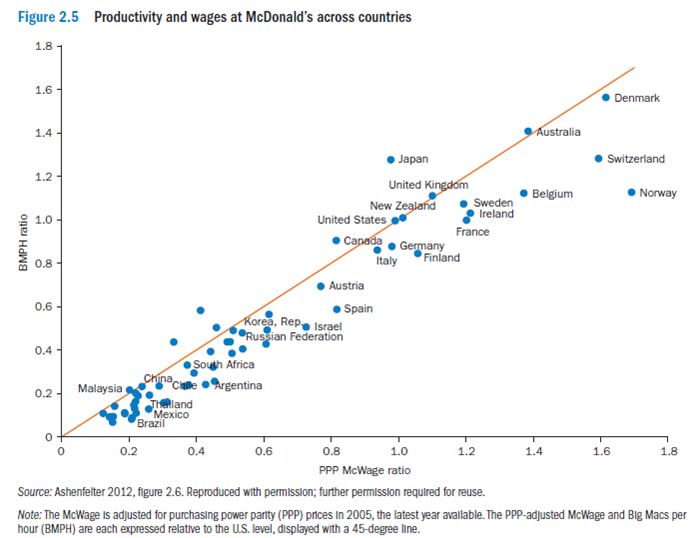
However, differences in economic and social environments across countries might mean that migrants can increase their wages. While the evidence from McDonald’s is suggestive, the ideal comparison is between the wages of identical workers working in different countries to see how much their incomes vary across countries. Although conceptually simple, empirical identification of this thought exercise can be challenging. One approach is to attempt to find non-migrants who “look” identical to migrants on observable characteristics such as gender, age, and education, and then compare the wages of these two groups. This is the approach adopted by Clemens, Montenegro, and Pritchett (2016) using data on immigrants in the United States. Their study estimates that typical individuals from an average developing country should expect to earn four to six times their income upon moving to the United States. Figure 2.6 presents the wage differences between workers in their home countries and in the United States. The fact that these wage differentials are not the result of differences in educational attainment or age suggests that migrants do experience large wage gains upon migrating from poorer to wealthier countries. Many of the factors that make a person productive are not intrinsic but are rather the result of the economic and social environment they work and live in. As a result, migrants, and the world as a whole, are, on average, better off if people are able to move to a wealthier country that has superior institutions, infrastructure, and complementary inputs.
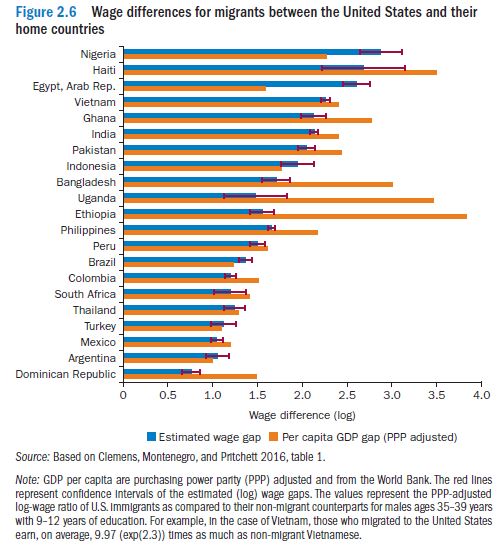
These estimates of wage gains, owever, should also be interpreted with caution. First, the wage gains are generally smaller than the gross domestic product (GDP) differentials, suggesting that all productivity differences are not fully eliminated with migration. Second, and more important, is that we do not have precise measures of human capital and other productivity characteristics of workers in most datasets. Migrants are likely to be different from non-migrants in a host of ways that are not easily measured or captured in surveys or censuses.
More convincing evidence that migration results in substantial wage gains comes from immigration lotteries. If the demand to migrate is much greater than the potential migration opportunities, destination countries’ governments sometimes offer a lottery to decide who gets to migrate. Such lotteries provide a “natural” experiment with which to measure the actual wage and employment impact of migrating. By comparing individuals who applied to a lottery and won to those who lost, we can isolate the pure effect of migration on wage earnings.
In a series of papers, McKenzie, Stillman, and Gibson (2010) and Gibson et al. (2018) analyze the Pacific Access Category of New Zealand, where a random ballot is used to choose from among applicants from Tonga and several other Pacific Islands. Figure 2.7 shows that winners and losers in the lottery had similar incomes in Tonga prior to migration (about $NZ 80, or US$58, per week). In the first year after winning the lottery and moving to New Zealand, the migrants earn 273 percent more than the non-migrants. This relative large wage gap persists almost 10 years later, with migrants earning 284 percent more, or an extra $NZ 359 per week. These wage differences are adjusted for differences in cost of living, and so represent true income gains from migration. Assuming these gains continue through the working lives of migrants, Gibson et al. (2018) estimate that the present discounted value of migrating to New Zealand is $NZ 315,000 (US$237,000) per migrant. This amount is orders of magnitude greater than the income gains from numerous development interventions that are commonly studied. In other words, migrating offers tremendous wage benefits.
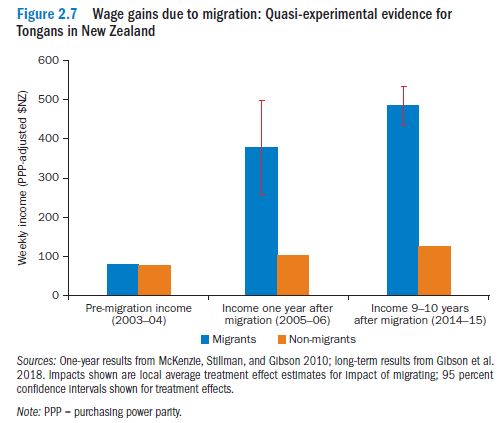
Employment differentials and migration
The relationship between migration flows and wage differentials tells only a part of the story on the labor market motivations of migration. Differences in employment rates and opportunities across geographic locations generate another set of important factors.
There is little evidence on the impact of employment rates on international migration flows. Nevertheless, existing data reveal some distinctive patterns. Figure 2.8 shows emigrant and immigrant shares in bilateral corridors plotted against differences in the employment-to-population ratio in destination and source countries. Panel a shows that emigrants, on average, choose higher-employment destination countries. Panel b shows that, again on average, immigrants tend to come from lower-employment countries. Similar evidence exists for refugees who also tend to go to destinations with higher employment rates and lower unemployment, controlling for other factors (see figure 2.9).
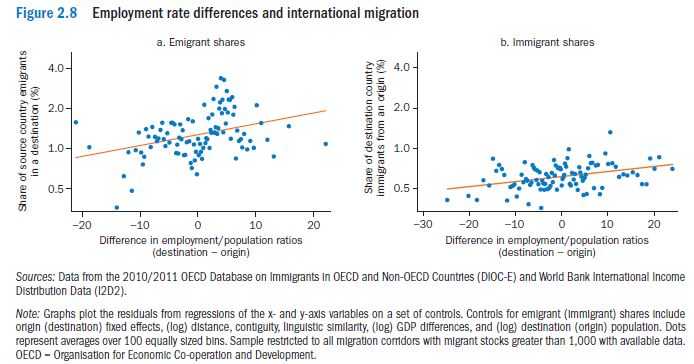
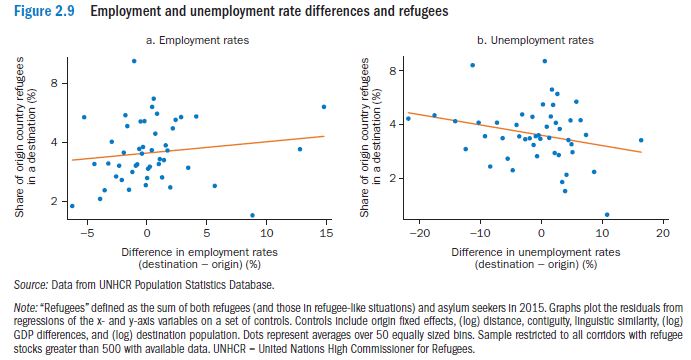
Changes in internal migration within a country over time are a rich source of evidence on the employment-related determinants of migration patterns. Especially for the United States, a large literature exists on mobility responses to labor market shocks. A central observation is that U.S. internal migration rates are strongly procyclical (Saks and Wozniak 2011), with most migrants moving to take advantage of opportunities created during good economic years, especially in locations with strong economic growth and job creation. It is less clear, however, whether internal migration smooths the negative shocks in bad times. The fact that aggregate migration rates tend to decline in downturns suggests that U.S. workers do not respond to negative economic shocks by moving to other parts of the country. Instead, people remain in their current locations until the economy starts recovering, even if that location is experiencing higher unemployment (Mian and Sufi 2012; Molloy, Smith, and Wozniak 2011).
The financial crisis of 2007–08 and the subsequent “Great Recession” seem to have created slightly different patterns, as argued in a recent paper by Monras (2015). The analysis shows that geographic relocation was important in itigating negative local economic shocks. However, the relocation mechanism involves decreased in-migration rates into negatively hit locations, rather than increased out-migration.
Addressing the same issue, Ransom (2016) observes that migration rates among unemployed workers were higher than among the employed during 2002–13. More interesting, the migration rates for the unemployed increased during the Great Recession, whereas the migration rate for the employed decreased slightly. The paper finds that the observed differences in migration rates by employment status are primarily due to the asymmetry in the job offer and job destruction rates over the Great Recession. More specifically, job offer rates decreased by about five times more than job destruction rates. Furthermore, employed workers face a steep job-queuing penalty when moving locations, whereas unemployed workers face no such penalty. These two factors together give employed workers an incentive to stay in their current location and keep their jobs, in contrast to unemployed workers, who are more likely to migrate.
Family and migration decisions
An objection to the claim that wage differentials are the main drivers of migration decisions is that many people, especially women, do not migrate for work-related reasons. Research has shown that family-related social reasons are often more prominent in influencing women’s migration decisions. For example, according to the 2001 census, Indian women are 2.5 times more likely to migrate internally than men. The reason is that marriage is by far the largest motivation for internal migration by women in India. Migration is nearly universal for women in rural areas, as seen in figure 2.10 (replicated from Fulford 2015). Despite significant regional differences, in most parts of India the norm is for women to be married outside of their natal village, joining their husband’s family in his village or town (this is called patrilocal village exogamy). Marriage accounts for 71 percent of all female migration in India. Men have more varied reasons: about 30 percent migrate for work, and a similar number migrate with their families. Over 70 percent of marriage migration is over a short distance and takes place within a district. Hence, women do not migrate far: only 9 percent move across state borders. Meanwhile, 20 percent of male migration in India is across states.
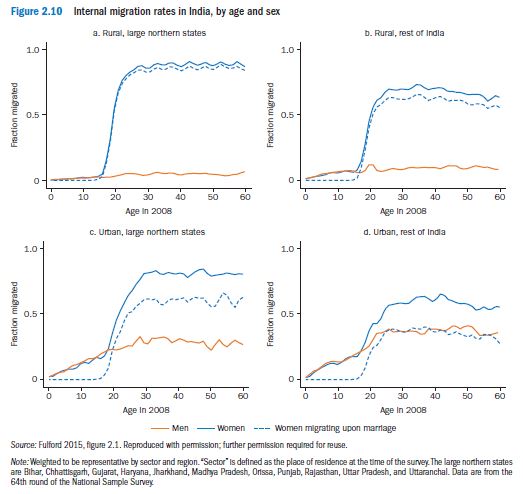
Turning to international migration, using data from the U.S. Office of Immigration Statistics to investigate the characteristics of immigrants to the United States also reveals interesting patterns. Non-work-related reasons seem to motivate a substantial portion of international migration to the United States. Most strikingly, men account for 70 percent of all visas that go to temporary workers and their families,5 despite the fact that dependents are included in these numbers. Relatively fewer women receive an H-1B visa. For the next stage of the immigration process, permanent residency status or the Green Card, figure 2.11 shows information on persons who obtained permanent residency disaggregated by gender.6 The data indicate that 48 percent of all female Green Card recipients in 2014 were homemakers, who mostly obtained it through family reunification policies, whereas this was the case for less than 3 percent of men. Meanwhile, 36 percent of men had a management or professional occupation, compared to only 16 percent of women.
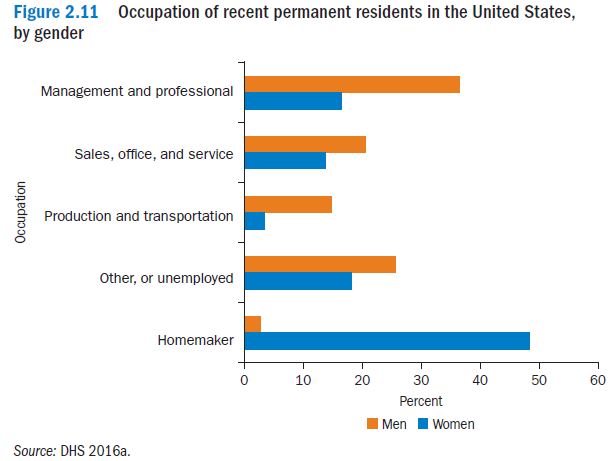
Clearly, there are gender differentials in what motivates migration, which raises the question: Do migration patterns related to wage differentials, unemployment rates, distance, and networks differ by gender? The available data suggest that the answer is no. Women and men may often move for distinct reasons, but their aggregate migration patterns are remarkably similar.
Panel a of figure 2.12 shows the emigration-to-population ratio by gender across countries. Practically all countries lie along the 45-degree line, meaning that the same proportion of each gender emigrates. Some of the few exceptions are smaller countries with many female emigrants, and Armenia, Grenada, Jordan, Lebanon, and the Virgin Islands, with many more male emigrants. The correlation between male and female emigration rates across the world is a remarkable 0.985.
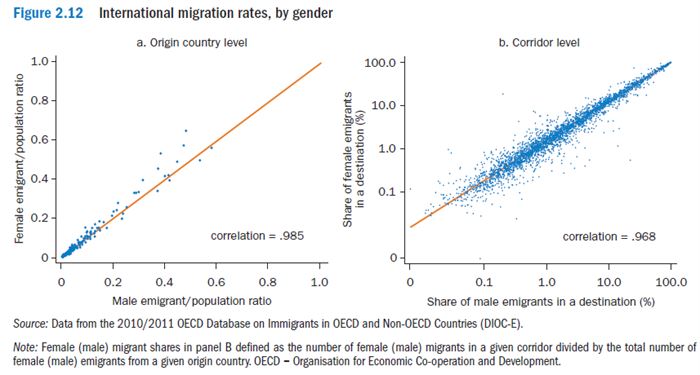
A similar pattern emerges when we analyze bilateral migration rates according to gender. Simply put, men and women from the same origin country tend to migrate to the same destination countries at the same rates. The scatterplot in panel b of figure 2.12 shows the (natural log) proportion of male migrants from each origin country to each destination country against the proportion of female migrants. The observations are tightly clustered around the 45-degree line, and the correlation across genders is 0.97. Even though male and female migrants from a country migrate to destination countries in very similar proportions, this is not necessarily true for all bilateral flows. For example, migrant flows from Indonesia to Saudi Arabia are disproportionately female (household employees) whereas those from Bangladesh to Oman and Malaysia are disproportionately male (agricultural and construction jobs). But these exceptions are not frequent despite the attention these outlier corridors receive in the media.
An explanation for this seeming puzzle is that both men and women in fact move for employment-related reasons but that women are more likely to be “tied movers.” If individuals migrate in search of higher wages and better employment opportunities and their spouses accompany them, then the spouses are indirectly moving for the very same economic reasons.
[※ World Bank. 2018. Moving for Prosperity: Global Migration and Labor Markets. Policy Research Report. Washington, DC: World Bank. doi:10.1596/978-1-4648-1281-1. License: Creative Commons Attribution CC BY 3.0 IGO
This translation was not created by The World Bank and should not be considered an official World Bank translation. The World Bank shall not be liable for any content or error in this translation.
This is an adaptation of an original work by The World Bank. Views and opinions expressed in the adaptation are the sole responsibility of the author or authors of the adaptation and are not endorsed by The World Bank.]
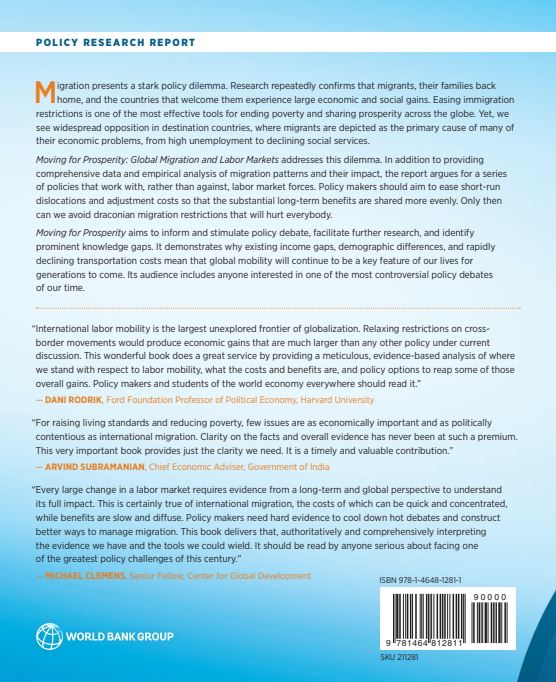 세계은행이 발행한 정책보고서 「번영을 위한 이주 : 국제이주와 노동시장」 뒷표지
세계은행이 발행한 정책보고서 「번영을 위한 이주 : 국제이주와 노동시장」 뒷표지
<pinepines@injurytime.kr>
저작권자 ⓒ 인저리타임, 무단 전재 및 재배포 금지